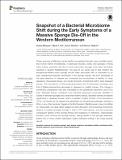Por favor, use este identificador para citar o enlazar a este item:
http://hdl.handle.net/10261/132867COMPARTIR / EXPORTAR:
 SHARE SHARE
 CORE
BASE CORE
BASE
|
|
| Visualizar otros formatos: MARC | Dublin Core | RDF | ORE | MODS | METS | DIDL | DATACITE | |

| Campo DC | Valor | Lengua/Idioma |
|---|---|---|
| dc.contributor.author | Blanquer, Andrea | es_ES |
| dc.contributor.author | Uriz, María Jesús | es_ES |
| dc.contributor.author | Cebrian, Emma | es_ES |
| dc.contributor.author | Galand, Pierre E. | es_ES |
| dc.date.accessioned | 2016-06-02T05:55:29Z | - |
| dc.date.available | 2016-06-02T05:55:29Z | - |
| dc.date.issued | 2016-05-19 | - |
| dc.identifier.citation | Frontiers in Microbiology 7 : 752 (2016) | es_ES |
| dc.identifier.uri | http://hdl.handle.net/10261/132867 | - |
| dc.description | 30 páginas, 7 figuras, 1 tabla. | es_ES |
| dc.description.abstract | Ocean warming is affecting marine benthic ecosystems through mass mortality events that involve marine invertebrates, in particular bivalves, corals, and sponges. Among these events, extensive die-offs of Ircinia fasciculata sponges have been recurrently reported in western Mediterranean. The goal of our study was to test whether the temperature-related mass sponge die-offs were associated with or preceded by an early unbalanced bacterial microbiome in the sponge tissues. We took advantage of the early detection of disease and compared the microbiomes of healthy vs. early diseased I. fasciculata tissues. Our results showed a microbiome shift in early diseased tissues. The abundance of Gammaproteobacteria and Acidobacteria increased and that of Deltaproteobacteria decreased in diseased vs. healthy tissues. The change in community composition was also noticeable at the operational taxonomic unit (OTU) level. Diseased tissues contained more bacterial sequences previously identified in injured or stressed sponges and corals than healthy tissues. Bacterial diversity increased significantly in diseased tissues, which contained a higher number of low abundance OTUs. Our results do not support the hypothesis of one particular pathogen, whether a Vibrio or any other bacteria, triggering the Northwestern Mediterranean mass mortalities of I. fasciculata. Our data rather suggest an early disruption of the bacterial microbiome balance in healthy sponges through a shift in OTU abundances, and the purported consequent decline of the sponge fitness and resistance to infections. Opportunistic bacteria could colonize the sponge tissues, taking benefit of the sponge weakness, before one or more virulent pathogens might proliferate ending in the mass sponge die-off. | es_ES |
| dc.description.sponsorship | AcknowledgmentsThis study has partially been funded by projects MarSymbiOmics (MINECO, I+D+I ofExcellence, CTM2013-43287-P), the Benthic Ecology Consolidate Team 2014-SGR-120(Generalitat de Catalunya), and BluePharm Train FP7 People-INT, to MU The work of PGwas supported by the Agence Nationale de la Recherche (ANR) through the projectsEUREKA (ANR-14-CE02-0004-01). | es_ES |
| dc.language.iso | eng | es_ES |
| dc.publisher | Frontiers Media | es_ES |
| dc.rights | openAccess | es_ES |
| dc.subject | Ircinia fasciculata | es_ES |
| dc.subject | Western Mediterranean | es_ES |
| dc.subject | Mass die-off | es_ES |
| dc.subject | Keratose sponges | es_ES |
| dc.subject | Early disease symptoms | es_ES |
| dc.subject | Microbiome profiling | es_ES |
| dc.subject | Microbiome shifts | es_ES |
| dc.subject | Bacterial symbionts | es_ES |
| dc.title | Snapshot of a Bacterial Microbiome Shift during the Early Symptoms of a Massive Sponge Die-Off in the Western Mediterranean | es_ES |
| dc.type | artículo | es_ES |
| dc.identifier.doi | 10.3389/fmicb.2016.00752 | - |
| dc.description.peerreviewed | Peer reviewed | es_ES |
| dc.relation.publisherversion | http://dx.doi.org/10.3389/fmicb.2016.00752 | es_ES |
| dc.identifier.e-issn | 1664-302X | - |
| dc.relation.csic | Sí | es_ES |
| oprm.item.hasRevision | no ko 0 false | * |
| dc.identifier.pmid | 27242765 | - |
| dc.type.coar | http://purl.org/coar/resource_type/c_6501 | es_ES |
| item.openairetype | artículo | - |
| item.grantfulltext | open | - |
| item.cerifentitytype | Publications | - |
| item.openairecristype | http://purl.org/coar/resource_type/c_18cf | - |
| item.fulltext | With Fulltext | - |
| item.languageiso639-1 | en | - |
| Aparece en las colecciones: | (CEAB) Artículos | |
Ficheros en este ítem:
| Fichero | Descripción | Tamaño | Formato | |
|---|---|---|---|---|
| Blanquer 2016.pdf | 715,26 kB | Adobe PDF |  Visualizar/Abrir |
CORE Recommender
PubMed Central
Citations
15
checked on 17-abr-2024
SCOPUSTM
Citations
36
checked on 19-abr-2024
WEB OF SCIENCETM
Citations
32
checked on 28-feb-2024
Page view(s)
274
checked on 23-abr-2024
Download(s)
319
checked on 23-abr-2024
Google ScholarTM
Check
Altmetric
Altmetric
Artículos relacionados:
NOTA: Los ítems de Digital.CSIC están protegidos por copyright, con todos los derechos reservados, a menos que se indique lo contrario.
